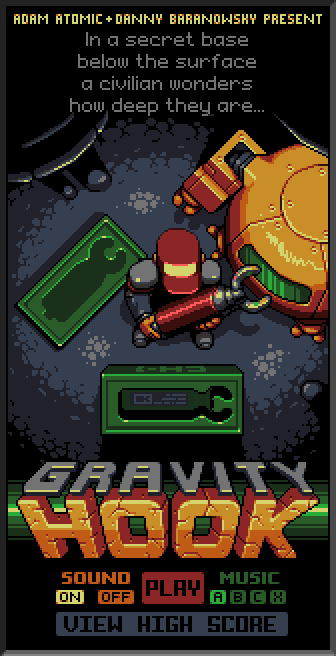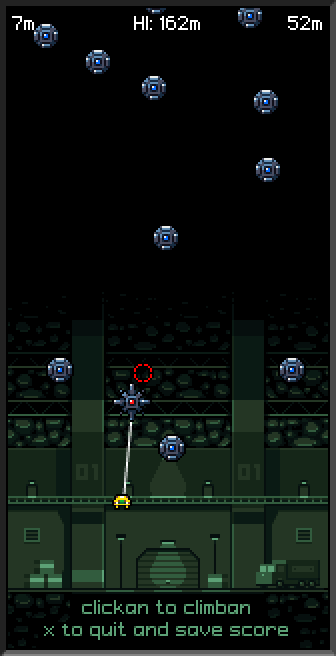Retro Replay Review
Gameplay
Gravity Hook delivers a straightforward yet deeply engaging gameplay loop that’s built around mastering momentum and timing. At its core, the game places you in control of a character equipped with a futuristic grappling hook, challenging you to ascend through an underground base by latching onto glowing nodes. Each grapple adjusts your velocity and trajectory, turning every swing into a judicious balance of risk and reward. Beginners will appreciate the intuitive click-and-release mechanic, while seasoned players will quickly discover the nuanced physics that reward well-timed releases and rapid chain grabs.
(HEY YOU!! We hope you enjoy! We try not to run ads. So basically, this is a very expensive hobby running this site. Please consider joining us for updates, forums, and more. Network w/ us to make some cash or friends while retro gaming, and you can win some free retro games for posting. Okay, carry on 👍)
What sets Gravity Hook apart is how it layers complexity on a deceptively simple premise. When you latch onto a node, you not only propel yourself upward but also drag the node downward, increasing the gap to the next target. This dynamic forces players to build speed, string together consecutive swings, and constantly adapt their strategy to the shifting node positions. As your ascent accelerates, so does the tension: nodes become armed, and lingering too long results in an instant, explosive demise. This high-stakes feedback loop transforms each climb into an adrenaline-fueled dance with gravity.
The randomized distribution of nodes on every playthrough injects endless replayability. No two ascents feel identical, compelling you to react in real time rather than memorize patterns. A persistent meter at the top of the screen tracks your highest reached altitude, while an online leaderboard showcases top performers from around the globe. This competitive element spices up each attempt, motivating you to refine your technique, chase personal bests, and climb the global ranks. Gravity Hook strikes a perfect balance between pick-up-and-play accessibility and a deep skill ceiling that keeps you coming back.
Graphics
Gravity Hook embraces a minimalist pixel-art aesthetic that perfectly complements its high-energy gameplay. The clean, crisp sprites are rendered in a limited color palette, evoking classic arcade titles while still feeling fresh. The underground base is depicted through shifting backgrounds that gradually transition from shadowy corridors to brighter, more open spaces as you ascend. These subtle visual cues reinforce your progression and keep the experience visually engaging without overwhelming the senses.
The nodes themselves are simple glowing orbs, but careful attention to animation breathes life into every interaction. When you latch on, the node visibly sags before snapping you skyward, and when it arms itself, it flashes a warning hue that instantly telegraphs danger. This clear feedback loop ensures that you always know when you’re at risk of explosion. Additionally, particle effects—such as sparks flying off tethered nodes and debris scattering upon detonation—add a satisfying punch to each near miss or untimely demise.
Transparency and layering are used effectively to convey depth in a 2D space. Background elements recede convincingly behind the playfield, while semi-translucent overlays indicate zones of imminent peril. Despite its retro stylings, Gravity Hook avoids feeling dated; the animations are smooth, collisions are handled with precision, and the overall presentation is both polished and purposeful. It’s a testament to how a well-executed pixel art style can be as modern and immersive as any high-resolution 3D world.
Story
While Gravity Hook isn’t a narrative-driven title in the traditional sense, it introduces an intriguing premise that instantly hooks players: you are a captive or test subject seeking to escape a clandestine underground facility. This backstory, though largely conveyed through a brief introduction and environmental design, adds layers of context to your vertical dash. Each explosive node you pass becomes a visual reminder of the base’s hazardous experimentation, and the ever-increasing brightness as you ascend hints at the freedom awaiting above.
The game’s story emerges organically through its mechanics and level design. No cutscenes or dialog interrupt the flow; instead, you piece together the setting by observing the facility’s architecture, scattered remnants of machinery, and the ominous glow of each node. This minimalist approach to storytelling invites your imagination to fill in the gaps, giving the experience a sense of mystery that intensifies with every meter you climb.
Gravity Hook’s implied narrative elevates the core gameplay loop, turning each swing into a step toward liberation. You’re not merely chasing a high score—you’re racing against an enigmatic organization determined to keep you confined. This undercurrent of urgency adds emotional weight to the explosive mechanics and reinforces the game’s theme of breaking free. It’s an inspired way to weave story into an action-focused experience without slowing down the pace.
Overall Experience
Gravity Hook stands out as a brilliantly focused title that excels in its simplicity. From the moment you start, it challenges you to learn its physics, hone your reflexes, and build muscle memory through repeated climbs. The short duration of each run—often under a minute—means that failure never feels punishing. Instead, each explosive demise beckons you to try again, fostering a “just one more attempt” mentality that makes it hard to step away.
The integration of an online leaderboard and persistent high-point trackers amplifies the game’s addictive qualities. Whether you’re aiming to surpass your own personal best or vying for a top spot among global competitors, there’s always incentive to sharpen your skills. The randomized node layouts ensure ongoing variety, so even if you reach a plateau in raw climbing ability, the unpredictability keeps each run fresh and exciting.
In summary, Gravity Hook delivers a tight, thrilling arcade experience that rewards daring play and constant adaptation. Its polished pixel visuals, clever physics-driven mechanics, and subtle narrative threads combine to create a package that’s easy to learn but difficult to master. For players who crave fast-paced challenge, competitive online features, and an unmistakable sense of vertical momentum, this underground escape adventure is a must-play.
 Retro Replay Retro Replay gaming reviews, news, emulation, geek stuff and more!
Retro Replay Retro Replay gaming reviews, news, emulation, geek stuff and more!





Reviews
There are no reviews yet.